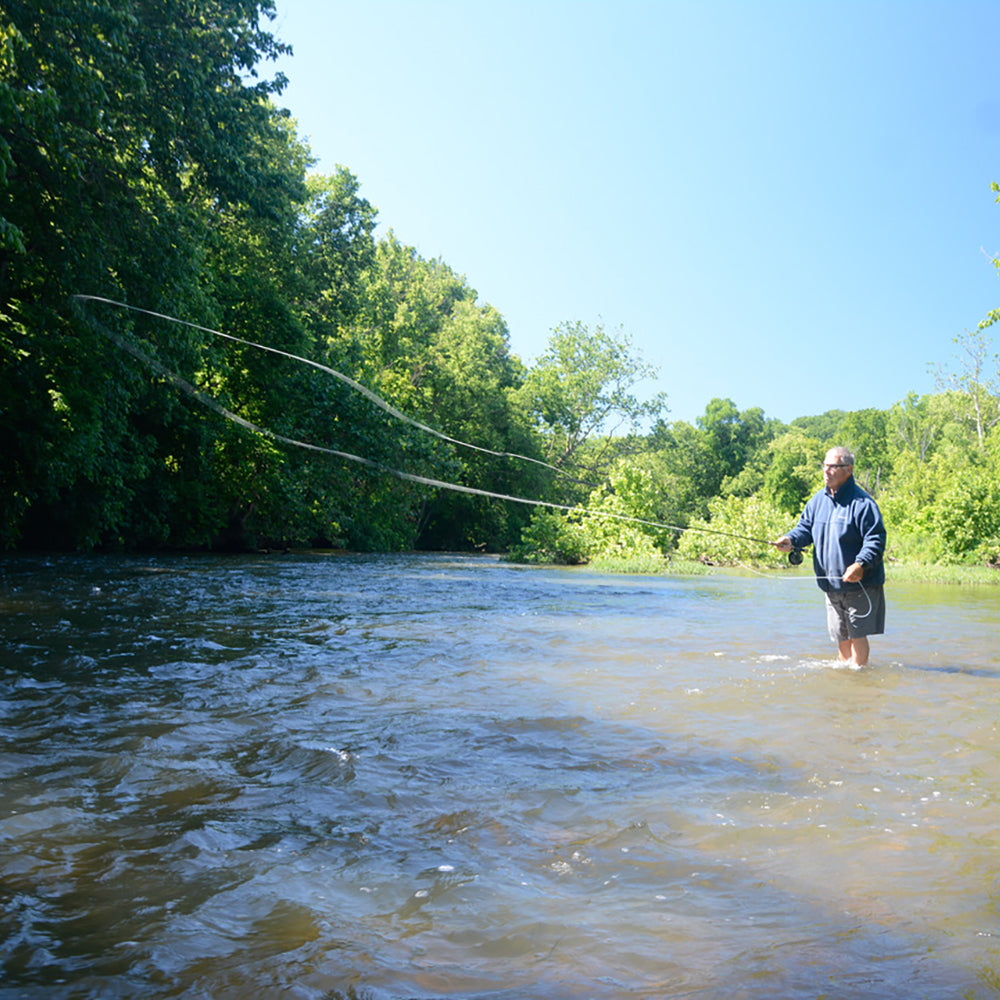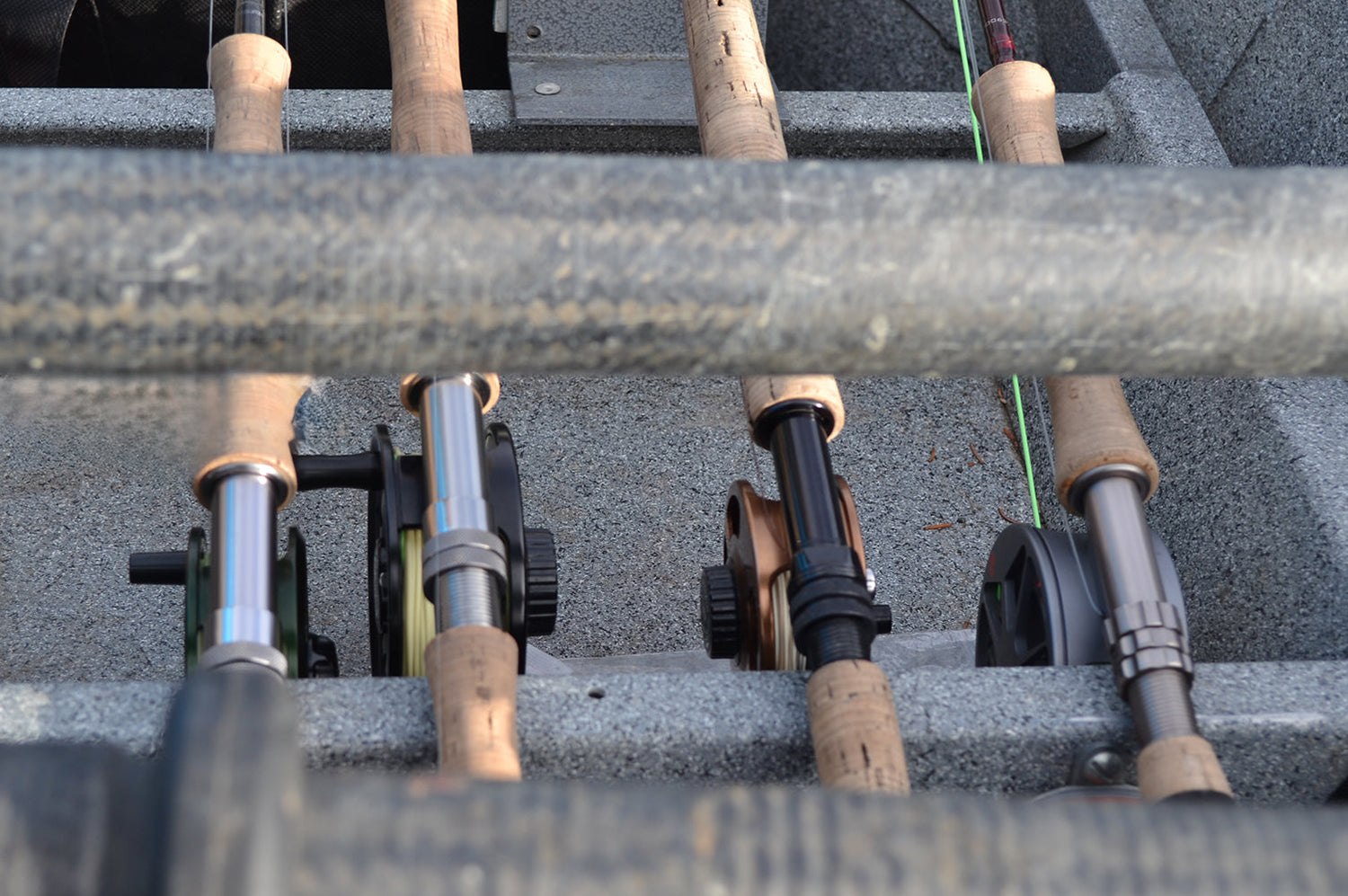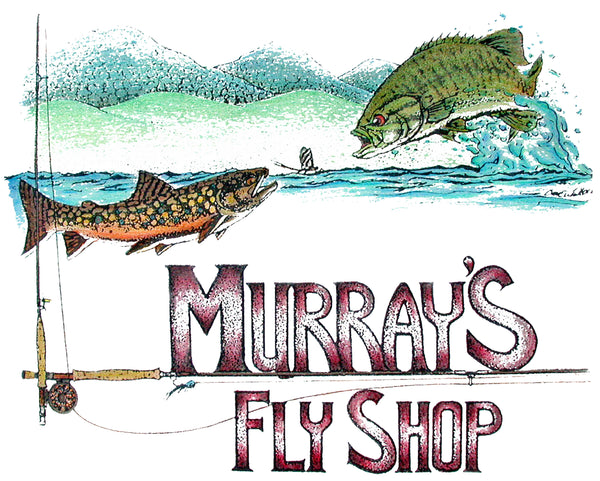Frequently Asked Fly Fishing Questions and Answers
Frequent Fly Fishing Questions and Answers
-
How far should I cast when fishing smallmouth rivers?
I never like to cast further than is necessary to prevent spooking the bass. This varies with the stream level and speed of the current but one can easily miss more strikes with extremely long casts.
-
Do you fish your Murray's Hellgrammite downstream, across stream or upstream?
All of the above! It's effective downstream because natural hellgrammites are excellent swimmers and the bass are accustomed to seeing them. I fish them across stream because with my "swing nymphing" tactic I can fish them on the bottom of the deepest runs. I fish them upstream "dead drift" because I can effectively pick the pockets below and in the riffles where the bass feed.
-
How do you feel about fishing for trout and smallmouths when they are on their spawning beds even though you plan to return them to the stream?
This is a decision for each angler to make, but I do not do it because I do not want to stress the fish.
-
How early and late in the year do you fish for smallmouth bass?
From mid April to end of October
-
If you could have only one streamer, nymph, surface bug and dry fly for smallmouths what would they be and why?
The Olive Strymph, Murray's Heavy Black Hellgrammite, Shenandoah Blue Popper, and Mr. Rapidan Skater would be my choice because if I can't catch the bass on these I usually can't catch them on anything.
-
I want to fish some deep pools for smallmouth but I want to stay with a floating line. Which bass streamer or nymph is the heaviest and will run the deepest?
The Murray's Madtom/Sculpin is tied with lead eyes plus the lead in the body and will help you dredge these depths. Plus you'll be showing the bass a natural food they are accustomed to seeing in that part of the river.
-
If I know the size fly I plan to fish how do I determine the size leader tippet I should use?
A simple way to determine this is to use this basic formula. Fly Size divided by 3 equals your tippet size in X. For example a size 12 Fly divided by 3 equals a 4X tippet. I cover this information in my "on the stream" schools.
-
When the wind is blowing straight into my face I have a terrible time getting the leader to turn over and lay the fly out straight. What can I do?
Keep your forward cast low so the wind doesn't grab it. A low side arm cast works as does overpowering your forward cast while getting the rod down close to the water.
-
What is the most popular line size and rods you sell for smallmouth fishing?
Weight forward 7 and 8 lines are ideal for smallmouth fishing. The Scott Radian 9ft. for a #7 line and 9ft. for a #8 line are by far our most popular bass rods.
-
At what water temperature in the spring can I expect to start catching trout on dry flies?
At normal water levels brook trout start feeding on the surface at 40 degrees while rainbows and browns do better at 45 degrees.
-
Can I expect to catch more than one trout in the same pool in a mountain trout stream?
In the spring when the streams are carrying a good water level I often catch more than one trout in some pools if I can fight and land the first trout away from the part of the pool I plan to fish next. However, late in the summer when the streams are very low and clear I usually have to be satisfied with one trout in each pool and frequently I feel very fortunate to catch that one.
-
What is the worst thing that spooks trout that prevents me from catching them in the pool I'm about to fish?
If you don't count falling into the pool with them, it is movement. This could be your movement as you approach the pool, the flash of the fly line going over the trout's head or even a bird flying over the stream. The trout will not hang around to discern between movements that pose a threat and those that don't, he just heads for a safer location.
-
If I drift my dry fly over a trout and he comes up and looks at it but refuses it, can I catch him if I keep drifting that fly over him?
Probably not. If it looked right he would have taken it on the first drift. I usually go to a smaller fly in a different shape. The Mr. Rapidan Ant in size 18 is a great "change of pace fly".
-
If you had only one fly rod to fish all mountain trout streams what would be it be?
Many years ago I was not satisfied with the accuracy and delicacy of the fly rods I was using so I contacted the Scott Rod Company to see if we could come up with an ideal rod for the small mountain stream fly fishing. After eleven months of testing and changing rod tapers we came up with the Murray's Mountain Trout Rod which is 6ft. 10 inches long, breaks down to 3 pieces and balances perfectly with a number 3 fly line. This is by far the most delicate and accurate rod I've ever used at close range and it's short enough to cast under the tree limbs. It is by far the most popular trout rod we well.
-
If you could have only four dry flies for your trout fishing all season what would they be?
These are the four dry flies I use for 90% of my trout fishing because historically they have done the job for me. Part of this is because they match a broad selection of natural foods and they all show the trout a different silhouette. They are the Mr. Rapidan Parachute size 14, the Murray's Flying Beetle size 16, the Mr. Rapidan Ant size 18 and the Baltz Para Nymph size 16.
-
How early and late in the year do you fish the mountains for trout?
From mid March to the end of September. The brook trout spawn in October, November, and December and I do not like to disturb them at this time.
-
My trout dry flies don't float well after I've used them for about a half hour even if I keep applying silicone cream, dry fly floatant or sprays. What's wrong?
Often the fly becomes so soaked that the floatant won't help. I use our Murray's Dry A Fly Patch to blot the fly dry when this happens then apply our Murray's Liquid Dry Fly Floatant. By doing this I can often fish for hours with the same fly.
-
The natural March Brown Mayflies that hatch in the spring are close to an honest size 12. Can I use a size 12 dry fly when this hatch is on?
My favorite dry flies when this hatch is on are the Mr. Rapidan Parachute Dry size 14 and the March Brown Dry size 14. I get a lot of refusals if I use a size 12 dry.
-
What is the difference between fly fishing and spin fishing?
Fly fishing works by casting the weight of the fly line which is large and heavy compared to monofilament or similar line used in spin fishing. Spin fishing works by casting a weighted lure with relatively small line in comparison to fly line.
-
What does it mean when someone talks about "X" weight line?
In fly fishing as with any other fishing there are many different sizes of lures/flies and each size will cast well with a certain "weight" line. The first 30 feet of line is weighted. This weight is then referenced to a chart that assigns a standard number (i.e. 3 wt. or 9 wt.). The larger the number, the more the line weighs. The more the line weighs, the heavier fly it will effectively cast (heavier line will pull heavier flies through the air.)
-
What are the differences between the different weight rods?
The rod manufacturers build rods to cast a certain weight line (first 30ft. of a fly line). The larger the line number (the more it weighs), the larger flies it will cast. For example a 2 weight fly rod for torut will cast small size dry flies and nymphs very well and provide a delicate presentation. If you would take an 8 wt. fly rod for bass tot he same stream you would lose all of your delicacy and accuracy. On the toher side of the coin if you took that same 2 wt. fly rod to your favorite smallmouth river it would be nearly impossible (at least painful) to cast a size 4 Madtom/Sculpin into your favorite streamer run, however the 8 wt. fly rod would perform just fine. In an effort to standardize the fly line weights, the AFTM (Association of Fishing Tackle Manufacturer) has assigned anumber rating given to fly lines to help match the fly rod with the correct line. In essence, each AFTM number is a measure of the weight of the first 30ft. of fly line. The key thing is that the fly line and fly rod rating should match so that the fly rod can cast the fly line properly:
To convert to metric - ounces: 1 Grain = 0.065 gm = 0.0023 oz.AFTM# Weight (Grains) Tolerance (Grains) 4 120 114-126 5 140 134-146 6 160 152-168 7 185 177-193 8 210 202-218 9 240 230-250 10 280 270-290 11 330 318-342 12 380 368-392
The most commonly used fly line weights in the America's are AFTM #7 or AFTM #8 as these are good all-round lines for stillwater fishing. Lighter weights such as AFTM #6 or less are mostly used for river fishing or where the angler mainly fishes nymphs or dry flies such as many trout streams and rivers. Heavier lines such as AFTM #9 or higher are mostly used for casting large flies and lures and are sometimes used for salmon fishing and saltwater fishing.
-
How do I decide how long a fly rod I need?
Consider how much overhead cover you encounter on your favorite stream (trees,brush). It there is an abundance of overhead cover opt for a shorter fly rod, I use some in the 6 1/2 foot range. If there is an abundance of open space stick with a longer rod, 9 ft. is standard. If you plan on floating, often you may want to consider a 9'6" rod which makes a days float fishing a little easier on the casting and presentation.
-
Which brand fly rod should I buy?
I recommend to all of our clients that they take the time to cast different fly rods themselves. I often hear I am just getting started and I don't know what I like. In that case I still encourage them to cast different rods and decide for themselves what they like or do not like because you may simply like or dislike the grip or the way a particular fly rod is balanced. From the abuse our equipment takes we definitely use the lifetime guarantee. I encourage everyone to purchase a rod with a lifetime guarantee (manufacturers vary on these details but all are basically the same, if you break it, they will fix it for a nominal fee (usually $50). This is one of purely personal preference, YOUR personal preference.
-
I'm planning a trout fishing trip to the Rocky Mountains and would like to take one of your fly fishing schools to improve my techniques. Which school should I take?
In our Smallmouth Bass On The Stream Fly Fishing schools we teach the same tactics for fly fishing nymphs and streamers which we use for trout out west. The casting and line handling methods we teach here are the same methods you will use for trout in the west.
-
Why does my leader tippet get twisted so badly when I'm casting?
This one gets many experience fly anglers. Either your fly is too large for the diameter of your tippet or your fly or bug is not symmetrical.
-
Do you prefer knotted, braided or knotless leader and why?
I like the knotted leader much better than the others because they cast better, present the fly better, are easier to repair and are easily customized to a particular situation i.e. wind, heavy flies, spooky fish.
-
I would like to purchase a sinking line for my bass fly rod. What works best?
I have found that the standard Wet Tip III fly line manufactured by Scientific Angler will meet most of my fly fishing needs. If I need to swim my flies even deeper still, I use a Scientific Angler Sonar Sink 30 Warm 200 Grain Fly line. I use a 6 ft. Murray's Sinking Fluorocarbon 2X with these lines, not a 9ft leader.
-

Learn Fly Fishing at Murray’s Fly Shop: Classes, Workshops & Schools
Welcome to Murray’s Fly Shop – Your Fly Fishing Learning Hub At...
-

Featured Flies of the Month
Harry Murray's recommended fly list for this time of the year. (January...
-

Fly Fishing Rod Outfits
Fly Fishing Rod and Reel Outfits for Smallmouth Bass fly fishing, Trout...



